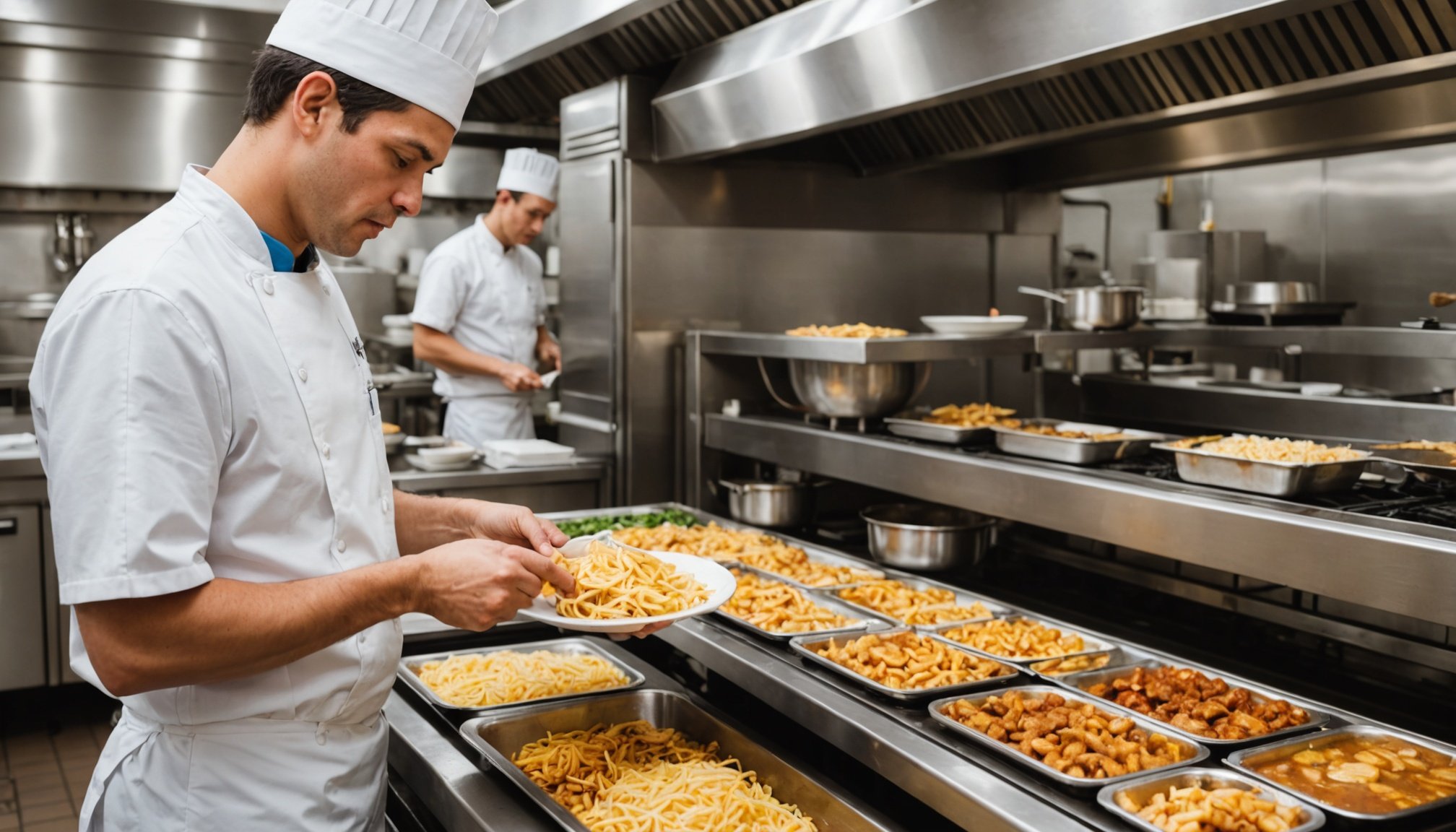Food traceability is no longer optional for restaurants; it’s a vital part of operational integrity and consumer trust. As regulations tighten, understanding and implementing effective compliance measures can set an establishment apart. From sourcing ingredients to maintaining clear records, restaurants must take essential actions to ensure transparency. This not only safeguards public health but also enhances brand reputation. Discover how to navigate this evolving landscape and establish a robust traceability system that meets industry standards.
Importance of Food Traceability Compliance
Understanding the significance of food traceability is crucial for maintaining high standards in the restaurant industry. It involves tracking the journey of food products from origin to consumption, ensuring compliance with food safety regulations. This process is pivotal in guaranteeing the quality and safety of food served to customers.
Topic to read : Create a unique signature cocktail to enhance your bar”s brand identity
Compliance significance extends beyond mere adherence to regulations; it offers several benefits. Maintaining compliance helps restaurants avoid legal penalties and enhances their credibility and trustworthiness. It also ensures that any potential food safety issues can be swiftly identified and addressed, minimizing risks to consumers and the business.
The consequences of non-compliance can be severe, impacting a restaurant's reputation and financial stability. Instances of foodborne illnesses linked to a restaurant can lead to loss of customer trust, negative publicity, and potential closure.
Also to see : From table scraps to treasure: your ultimate guide to implementing an organic waste composting system in restaurants
Consider these key points:
- Food traceability ensures accountability and transparency.
- Compliance with food safety regulations protects public health.
- Non-compliance can result in legal actions and business loss.
Incorporating robust food traceability systems and adhering to compliance significance can significantly benefit restaurant operations, fostering a safe dining environment for all patrons.
Understanding Food Traceability Regulations
Understanding the intricacies of food traceability regulations is crucial for restaurant operators. These regulations, encompassing local, state, and federal levels, form a comprehensive regulatory landscape designed to uphold food safety standards. Each level of government plays a distinct role in enforcing these laws, ensuring that food products are safe for consumers.
Key regulatory bodies include the Food and Drug Administration (FDA) and the United States Department of Agriculture (USDA). These organizations are instrumental in setting and monitoring compliance with food safety laws. Their guidelines dictate how food traceability should be maintained, from production to the point of sale.
Recent changes in food traceability laws have introduced more stringent requirements, emphasizing the need for robust tracking systems. These changes have significant implications for restaurants, which must adapt to ensure compliance. Failure to do so can result in severe penalties and loss of business credibility.
- Local Regulations: Vary by municipality, often more stringent.
- State Regulations: Provide additional guidelines complementing federal laws.
- Federal Regulations: Overarching standards applicable nationwide.
Restaurants must stay informed about these evolving regulations to maintain compliance and protect public health. Adapting to these changes not only ensures legal compliance but also enhances consumer trust.
Steps to Implement Food Traceability
Implementing food traceability in restaurant operations requires a strategic approach. This involves creating a comprehensive traceability plan tailored to the specific needs of your establishment. Begin by identifying and documenting critical tracking points within your supply chain. These points are essential for maintaining an accurate record of food products from origin to consumption.
Once you have established your plan, focus on training staff. Educating employees on traceability protocols and best practices ensures consistency and compliance with regulations. It's crucial for staff to understand the importance of precise documentation and the role they play in the success of your traceability efforts.
Key Steps in Traceability Implementation:
- Develop a Tailored Plan: Customize your traceability plan to fit your restaurant's unique operations.
- Identify Critical Points: Document supply chain checkpoints where tracking is essential.
- Staff Training: Conduct comprehensive training sessions on protocols and best practices.
By methodically addressing these steps, restaurants can enhance their food tracking methods and ensure compliance with traceability practices. This not only safeguards public health but also boosts consumer confidence in the safety and quality of the food served.
Tools and Technology for Food Traceability
Enhancing restaurant operations with advanced solutions.
Overview of Available Tools and Software
Incorporating traceability tools and technology solutions is crucial for modern restaurant operations. These tools range from simple barcode systems to advanced tracking software that integrates with existing management systems. Such technology ensures precise monitoring of food products, enhancing both safety and efficiency.
Integrating Technology into Existing Systems
Integrating technology solutions into restaurant management requires careful planning. Start by evaluating current systems to identify compatibility with new tracking software. This integration can streamline operations, providing real-time data on inventory and supply chains, thus ensuring compliance with traceability regulations.
Case Studies of Successful Implementations
Several restaurants have successfully adopted traceability tools. For example, a renowned chain implemented a comprehensive tracking software system, resulting in improved inventory accuracy and reduced waste. These benefits highlight the potential of technology solutions to transform food traceability practices.
- Key Benefits:
- Enhanced accuracy in tracking
- Improved compliance with regulations
- Reduction in food waste
By leveraging these traceability tools, restaurants can not only meet regulatory requirements but also gain a competitive edge. Embracing technology solutions fosters a transparent and efficient supply chain, ensuring the delivery of safe and high-quality food to consumers.
Best Practices for Maintaining Traceability
Enhancing operational efficiency and food safety standards.
Routine Audits and Reviews
Regular audits and reviews of traceability processes are essential for maintaining operational efficiency. These evaluations help identify areas for improvement, ensuring that food safety standards are consistently met. Implementing a routine schedule for audits can uncover discrepancies in record-keeping and highlight potential risks in the supply chain.
Importance of Accurate Record-Keeping
Accurate record-keeping is the backbone of effective traceability. It ensures that every step of the supply chain is documented, facilitating swift action in case of food safety issues. Restaurants should establish protocols for maintaining detailed records, covering everything from ingredient sourcing to final delivery. This practice not only supports compliance but also enhances operational efficiency.
Strategies for Ensuring Traceability
To ensure comprehensive traceability throughout the supply chain, restaurants can adopt several strategies:
- Implement Digital Systems: Use digital tools for real-time tracking.
- Train Staff Regularly: Educate employees on best practices.
- Collaborate with Suppliers: Work closely with suppliers to ensure transparency.
These strategies contribute to maintaining high food safety standards. By focusing on best practices, restaurants can safeguard their operations, protect public health, and uphold their reputation. Emphasizing thorough audits, meticulous record-keeping, and strategic planning fosters a robust traceability framework.
Engaging Suppliers in Traceability
Enhancing supply chain transparency through collaboration.
Importance of Supplier Collaboration
Collaborating with suppliers is integral to achieving effective traceability within the supply chain. Establishing a partnership with suppliers ensures that all parties are aligned with the traceability goals, enhancing the overall efficiency of the process. By working closely with suppliers, restaurants can guarantee that the traceability standards are met, thus safeguarding food safety and quality.
Establishing Clear Requirements
To foster traceability collaboration, it's crucial to define clear requirements in supplier contracts. These contracts should specify the traceability expectations, such as documentation standards and data sharing protocols. This clarity helps in maintaining consistency across the supply chain, ensuring that every supplier adheres to the established guidelines.
Building Strong Relationships
Building robust relationships with suppliers can significantly enhance compliance with traceability standards. Strong partnerships facilitate open communication, allowing for quick resolution of any traceability issues that may arise. Trust between restaurants and suppliers is the foundation for a transparent and efficient supply chain.
- Supplier Engagement: Essential for effective traceability
- Traceability Collaboration: Ensures alignment of goals
- Supply Chain Management: Enhances compliance and efficiency
Engaging suppliers effectively not only streamlines operations but also fortifies the restaurant's commitment to food safety and quality assurance.
Training and Educating Staff
Empowering employees with essential knowledge for compliance.
Developing Training Programs
Creating comprehensive training programs is essential to ensure staff training is effective. These programs should focus on food safety and traceability, equipping employees with the necessary skills to uphold compliance standards. By integrating hands-on activities and real-world scenarios, staff can better understand the importance of precise documentation and compliance awareness.
Ensuring Continuous Education
The landscape of regulations is ever-evolving, making continuous education crucial for maintaining compliance awareness. Regular workshops and seminars can keep employees informed about the latest food safety guidelines. This ongoing education helps staff adapt to changes and fosters a proactive approach to employee education.
Encouraging a Culture of Accountability
Fostering a culture where accountability is prioritized encourages staff to take ownership of their roles in maintaining compliance. By promoting open communication and setting clear expectations, employees become more engaged in food safety practices. Encourage feedback and suggestions from staff to continuously improve training programs and compliance awareness.
- Training Programs: Focus on food safety and traceability
- Continuous Education: Keep up with evolving regulations
- Accountability Culture: Encourage staff ownership and engagement
These strategies ensure that staff training not only meets regulatory requirements but also enhances the overall safety and quality of restaurant operations.
Monitoring and Reporting for Compliance
Ensuring adherence to regulations through systematic checks.
Setting Up a Monitoring System
Establishing an effective monitoring system is essential for maintaining traceability compliance in restaurant operations. This system should include regular traceability audits to identify and rectify any discrepancies. Implementing digital tools can streamline these processes, providing real-time data and reducing the risk of human error. A well-structured monitoring system not only ensures compliance but also enhances operational efficiency.
Understanding Reporting Obligations
Restaurants must be aware of their reporting requirements to meet regulatory standards. This involves maintaining detailed documentation of all traceability activities. Accurate records are crucial for demonstrating compliance during inspections. Restaurants should establish protocols for consistent reporting, ensuring that all necessary data is readily available for review by regulatory bodies.
Preparing for Inspections and Audits
Preparation is key to successfully navigating inspections and audits by regulatory agencies. Restaurants should conduct internal audits to assess their compliance levels and identify areas needing improvement. Regular staff training on compliance monitoring and reporting requirements can further ensure readiness for official evaluations.
- Monitoring System: Essential for compliance
- Reporting Obligations: Maintain detailed records
- Inspections and Audits: Conduct internal reviews
By focusing on these areas, restaurants can uphold high standards of traceability compliance and safeguard their reputation in the industry.
Case Studies of Successful Compliance
Insights into effective traceability practices.
Highlighting Successful Restaurants
Several restaurants have excelled in achieving food traceability compliance, setting benchmarks for the industry. One notable example is a renowned restaurant chain that integrated a comprehensive tracking system, significantly enhancing their compliance. This success story demonstrates the importance of investing in robust traceability systems to ensure compliance and boost consumer trust.
Lessons Learned from Challenges
The journey to compliance is not without its challenges. Many industry peers have faced hurdles such as adapting to new regulations and training staff effectively. However, these challenges have provided valuable lessons. For instance, prioritizing employee education and regular audits can streamline operations and ensure adherence to traceability standards.
Best Practices from Case Studies
- Employee Training: Regular workshops to keep staff informed.
- System Integration: Implementing advanced tracking technologies.
- Supplier Collaboration: Building strong relationships for transparency.
These best practices derived from successful compliance case studies illustrate the strategies that can lead to effective traceability compliance. By learning from these examples, restaurants can enhance their operations, ensuring they meet regulatory requirements and maintain high standards of food safety.
Future Trends in Food Traceability
Exploring the evolving landscape of food safety.
Anticipated Changes in Food Traceability Regulations
The future of food traceability is poised for significant transformation. As evolving regulations become more stringent, restaurants must adapt to ensure compliance. Anticipated changes include more detailed documentation requirements and enhanced reporting obligations. These adjustments aim to improve transparency and accountability in the food supply chain, safeguarding public health.
Innovations in Technology Shaping Traceability
Technological innovations are set to revolutionize traceability practices. Emerging technologies such as blockchain and IoT devices offer advanced solutions for tracking food products in real-time. These tools enhance the accuracy and efficiency of traceability systems, allowing for seamless integration with existing restaurant operations. By leveraging these innovations, establishments can stay ahead of regulatory demands.
Preparing for Next-Generation Compliance Standards
To prepare for the next generation of food safety compliance standards, restaurants should focus on proactive strategies. This includes investing in cutting-edge technology and fostering a culture of continuous improvement.
- Key Preparations:
- Implementing digital tracking systems
- Regular staff training on new technologies
- Collaborating with industry experts for insights
By embracing these future trends, restaurants can ensure they remain compliant with evolving regulations and maintain high standards in food traceability. This proactive approach not only protects consumers but also enhances the restaurant's reputation in a competitive market.











